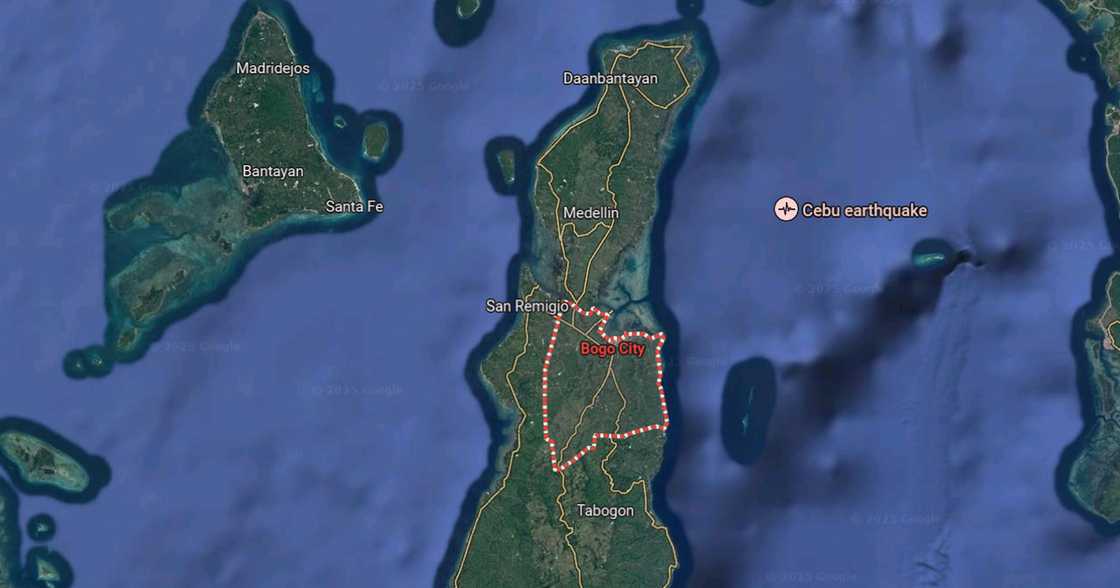Cebu earthquake: Fault dormant for centuries caused Cebu's deadly magnitude 6.9 quake
• PHIVOLCS identified the source of the recent magnitude 6.9 Cebu earthquake as an offshore fault
PAY ATTENTION: stay informed and follow us on Google News!
• The fault had been seismically dormant for at least 400 years, leading to a greater accumulation of destructive energy
• The earthquake's epicenter was shallow, contributing to the Intensity VII shaking and the high casualty count of nearly 70
• Cebu lies in a seismically active region with multiple known and unnamed fault systems capable of generating strong tremors
The Philippine Institute of Volcanology and Seismology (PHIVOLCS) has revealed that the powerful magnitude 6.9 earthquake that struck Cebu province on the night of September 30 was triggered by an offshore fault that had been seismically inactive for at least 400 years.

Source: UGC
PAY ATTENTION: Follow us on Instagram - get the most important news directly in your favourite app!
The devastating tremor, which claimed at least 69 lives and injured 186 people across Cebu, with Bogo City, San Remigio, and Medellin being the most affected, originated from a previously quiet fault system.
The quake’s epicenter was located off the coast near Bogo City, hitting at a dangerously shallow depth of five kilometers and causing massive damage due to the intense shaking.
During a press conference, Dr. Winchelle Ian Sevilla, chief of PHIVOLCS' Seismological Observation and Earthquake Prediction Division, confirmed that their catalog indicates this particular fault had not moved to generate a strong earthquake in the epicentral area for centuries.
"At least in the last 400 years, iyong pong fault na nag-generate dito ngayon lang po ulit siya gumalaw. So medyo matagal po siya gumalaw kaya siya medyo malakas. Based po ito sa ating catalogue," Dr. Sevilla explained.
The long period of dormancy is a key factor explaining the sheer force of the event. When a fault remains locked for an extended time, it accumulates a significant amount of tectonic strain energy, which, when finally released, results in a much more powerful and destructive earthquake.
The lateral, or side-to-side, movement of the fault was a primary characteristic of the shallow tremor.
PHIVOLCS has tentatively labeled the source as an 'offshore fault' since it is situated beneath the sea. Dr. Sevilla noted that the agency is dispatching a Quick Response Team to the epicentral area to install monitoring equipment, pinpoint aftershock locations with greater accuracy, and conduct a thorough assessment.
The goal is to fully understand the characteristics of this newly active fault system, which currently does not have a formal name in the agency’s active fault database.

Read also
Zsa-Zsa Padilla personally goes to Cebu and hands over ready-to-eat food packs and monetary aid
The incident is a sobering reminder that Cebu and its adjacent provinces are situated in one of the country's most seismically active regions.
PHIVOLCS noted that aside from known hazards like the Bogo Fault, the Daanbantayan Lineament, and the larger Cebu Fault System, the region is riddled with other local inland and offshore faults, some of which are concealed by deposits, but remain capable of generating strong earthquakes.
Historical data reinforces this threat, with PHIVOLCS documenting at least eight significant tremors with magnitudes between 5.0 and 7.2 that have impacted Cebu and neighboring provinces between 1885 and 2013.
These include the 2012 magnitude 6.9 earthquake in Negros Oriental and the 2013 magnitude 7.2 Bohol earthquake, both of which caused damage to Cebu's infrastructure.
The recent powerful movement of this four-century-old dormant fault underscores the critical need for constant vigilance and enhanced disaster preparedness across the Visayas region.
News, photos, or videos that arouse the interest of netizens would often go viral on social media, due to the attention netizens give them. These viral posts appeal to the emotions of netizens, and in rare cases, this could also happen to ordinary people, making them very relatable stories for all of the ordinary people in the country as today.
CCTV footage revealed a fake holdup inside a Quezon City grocery, where suspects staged an armed robbery involving a cashier. Police later confirmed it was an inside job, with the 21-year-old cashier identified as the alleged mastermind. Four suspects were arrested, including a 23-year-old, a 20-year-old lookout, and a 17-year-old minor; authorities recovered a replica gun and P13,200. All suspects admitted guilt, claiming financial hardship drove them to commit the crime; they now face robbery charges and other violations.
Three Philippine Coast Guard (PCG) personnel were killed in the magnitude 6.9 earthquake that hit Cebu on September 30. The fatalities were identified as Seaman Second Class Lawrence Palomo, Apprentice Seaman Jujay Mahusay, and Apprentice Seaman Ert Cart Dacunes. They died when the San Remigio Sports Complex tragically collapsed while they were reportedly playing basketball. The PCG expressed deep condolences, vowing full support to the families of the young men who were declared dead on arrival at the hospital.
Bagong feature: Tingnan ang mga balitang para sa'yo ➡️ hanapin ang "Recommended for you" block at mag-enjoy!
Source: KAMI.com.gh



